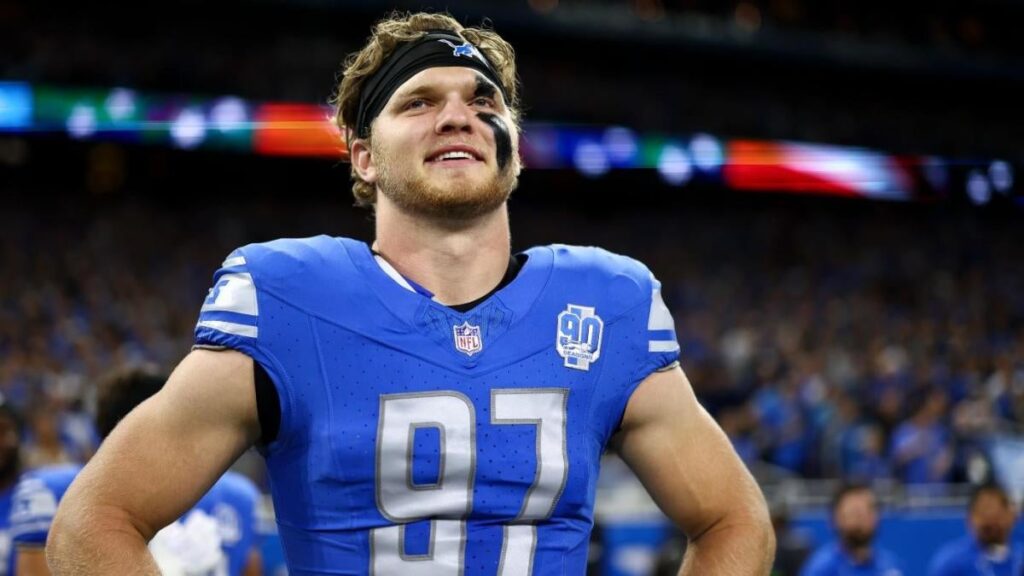
The complete structure of Aidan Hutchinson’s new four-year, $180 million extension has been revealed, and it’s time to dig into the real numbers behind the deal.
Most fans immediately head to Spotrac or OverTheCap to check contract data, and while those sites are fast and detailed, they don’t always reflect how the Detroit Lions structure their extensions. The team frequently includes what’s known as an “option bonus”, and those bonuses often make contracts look more flexible on paper than they actually are.
Take Hutchinson’s new deal, for instance. Both salary cap tracking sites make it appear as if Detroit could move on from him in 2028 with just a $6 million dead cap hit, or in 2029 with only $3 million in dead money while saving roughly $51 million. Sounds like a steal, right?
Not quite.
That’s a misleading picture because those databases don’t calculate the effect of option bonuses until they’re officially exercised. Once you include those, Hutchinson’s deal looks very different.
What Exactly Is an Option Bonus?
An option bonus is similar to a salary payment that must be triggered in a specific year, but its cap hit is spread evenly over the remaining seasons of the contract (up to a five-year span).
For teams: It helps reduce the cap hit in the current year.
For players: It guarantees more money and long-term financial security.
However, once the bonus is activated, the guarantees become locked in—meaning the team can’t escape or restructure those amounts later.
Hutchinson’s Option Bonuses and Cap Effects
Instead of massive base salaries in 2026, 2027, and 2028, the Lions included option bonuses of $28.4 million, $28.3 million, and $28.2 million, respectively. Once those are exercised, they each add about $5.6 million per year in prorated cap hits over the next five seasons.
When the contract expires in 2031, all remaining prorations accelerate into that final season, creating around $45 million in dead cap if Hutchinson isn’t re-signed.
If Detroit chooses to extend him again before 2031, those bonus amounts would simply carry over into the new deal, spreading the cost further and avoiding the huge one-year hit.
What If the Lions Try to Move On Early?
Let’s imagine the Lions consider releasing Hutchinson before his salary spikes to $29.55 million in 2029. Because the 2026–2028 bonuses would have already been exercised, cutting him then would result in roughly $54 million in dead money.
It gets worse — Hutchinson’s $29 million salary for 2029 becomes fully guaranteed on March 15, 2028, meaning that if he’s still on the roster at that time, releasing him the following year would cost Detroit nearly $83 million in dead cap. His projected 2029 cap hit if retained? $53,988,400.
Even moving on before the final season (2030) wouldn’t help much. Though there’d be no guaranteed base salary left, Detroit would still face around $50 million in dead cap from prior bonuses — almost equal to his $49,988,400 scheduled cap hit.
The Real Cap Picture
Here’s what the true financial commitment looks like once you factor in how the bonuses spread over time. The only way Detroit could cleanly exit the contract would be immediately after the 2025 season, before any of those options take effect — something that clearly won’t happen.
As a result, the Lions are effectively tied to Hutchinson for the majority, if not the entirety, of this deal — unless they decide to rework it near 2029 or 2030.
And if you’re wondering about a trade? That’s not realistic either. In a trade scenario, Detroit would retain all the option bonus prorations, while only the base salary transfers to the acquiring team — making a deal financially painful for the Lions.
Hutchinson’s Annual Cap Hits vs. Other Edge Rushers
Here’s how Hutchinson’s cap hits stack up league-wide at his position:
2025: $14.4 million — 14th among edge defenders
2026: $10.1 million — 36th
2027: $16.0 million — 20th
2028: $21.7 million — 11th
2029: $54.0 million — 3rd
2030: $50.0 million — 2nd
Detroit’s front office has clearly designed this deal to stay team-friendly during the first few seasons, which perfectly aligns with the timeline when big-money extensions for Jared Goff, Penei Sewell, and Amon-Ra St. Brown will hit the books.
It’s a deliberate strategy — managing multiple stars under the cap by backloading contracts while keeping the early years affordable.
The Bottom Line
Aidan Hutchinson’s extension is far more complex than it appears on salary tracking websites. Once the option bonuses are triggered, the deal locks both sides into a long-term commitment, with very little financial flexibility for Detroit until the final years.
Still, given how the cap is structured, the Lions are getting excellent value early on — paying below-market prices for an elite pass rusher during their championship window.
Expect Hutchinson to remain in Detroit through at least 2029, unless another extension reshapes the numbers yet again.





